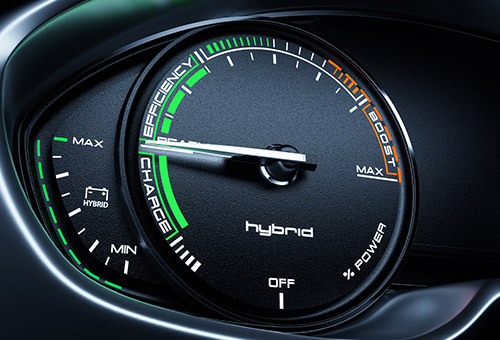[currently being updated]
The vehicle is equipped with a combined IC/electric powertrain system and two energy storage systems: a fuel tank and a battery.

Energy use optimization
Hybrid vehicles present significant energy management optimization potential. By combining two types of powertrains, it is possible to select the best operating mode (IC, electric or combined) depending on the profile of the journey, reserving the use of the IC engine for when it is most efficient. Consequently, local pollutant and CO2 emissions are reduced, as is fuel consumption (between 10 and 50% depending on the degree of hybridization).
Flexible implementation
Hybridization is not limited to the electric motor/gasoline engine pairing since it is also possible to pair up an electric motor with an engine running on diesel, biofuels or natural gas.
The different types of hybrid vehicles
Depending on the vehicle range and performances sought, the degree of hybridization - i.e., the electric power available onboard the vehicle - can be enhanced with the addition of complementary functionalities such as braking energy recovery, increase engine torque, the optimization of onboard energy management or rechargeable batteries (plug-in).
Micro-hybrid : the use of the “Stop&Start” system whereby the engine cuts out automatically when the vehicle is stationary (at traffic lights for example).
Mild-hybrid : the mild-hybrid system incorporates an alternator starter that delivers additional power to the IC engine during accelerations or at very low speeds. The electric motor thus provides back-up power for the engine but will never drive the vehicle on its own.
Full-hybrid : this is the highest degree of hybridization. Since the two powertrains use different energies, they can operate either separately or together, depending on speed, power and energy reserves.
At low speeds and when the battery is charged, the electric motor starts and propels the car. At high speeds or when the battery is discharged, the IC engine takes over. When more power is required to move off again or accelerate, the two systems operate together.
Plug-in hybrid: the vehicle has a battery with a bigger capacity (between 8 and 15 kWh), that can be recharged independently of the operation of the IC engine, by plugging it into an external power source. With this battery, it is possible to drive in all-electric mode over longer distances.
Good environmental performances
The reduction in fuel consumption and hence CO2 emissions depend on the degree of vehicle electrification:
- Between 3 and 7% for Stop&Start models whereby the IC engine cuts out when the vehicle is stationary;
- 20 to 30% for Full hybrid models capable of operating in all-electric mode over short distances (between 1 and 5 kilometers), thanks, in particular, to electric energy recovery during braking.
- As for plug-in models able to operate in all-electric modes over long distances, their CO2 emissions can be reduced by between 50 and 90% in the urban setting, provided the electricity produced comes from a low-carbon source, as is the case in France.
Technical and economic challenges
The principal challenges relating to the deployment of these hybrid technologies concern:
- The cost of the electric equipment (motor, power electronics) and transmission systems combining the two types of powertrain (IC and electric)
- Battery performance. Battery energy density and power must be increased and the cost lowered, while ensuring optimal safety conditions.
Lithium-ion and lithium-polymer batteries represent real progress in terms of onboard power compared with nickel-metal-hydride batteries. But they are more expensive
- Another key component is the supervisor, the central nervous system of the vehicle that manages onboard energy, air-conditioning systems, braking and recharging infrastructures. The complexity of hybrid vehicles, which combine two powertrain and storage systems with a large variety of architectures, requires real-time management via software embedded in onboard controllers to optimize battery charge, reduce consumption and improve drivability at all times.
By 2030 in Europe, hybrid vehicles may account for one third of sales.





